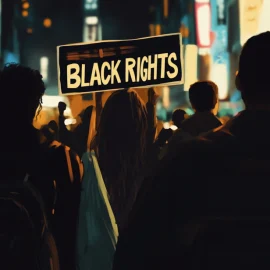

This article is an excerpt from the Shortform book guide to "Stamped from the Beginning" by Ibram X. Kendi. Shortform has the world's best summaries and analyses of books you should be reading.
Like this article? Sign up for a free trial here.
Was the Civil Rights Act a victory over racism? How did postracialism undermine antiracist positions?
As the post-Civil Rights era settled in, the myth of postracialism overtook American consciousness. According to Ibram X. Kendi, the author of Stamped From the Beginning, the idea of postracialism is an inherently racist concept because it obscures racist policies and their effects.
Here’s how the idea of postracialism evolved—and why it’s wrong.
The Myth of Postracial America
As Black people gained legal protections and society moved away from open racism and discrimination, leaders started talking about a “color-blind” or “postracial” society. The idea of color-blindness seems appealing—it implies that nobody notices or cares about racial differences, which in turn suggests that racism is no longer an issue. But Kendi points out that not seeing race means not seeing the racial disparities that exist because of racism.
Moreover, he points out that postracialism undermines antiracist positions by delegitimizing any accusations of racism. As Kendi explains, postracial logic says that people who criticize racist policies or behaviors are themselves racist because they’re insisting on racial differences even though race isn’t an issue anymore. Kendi suggests that this is a new way of accusing someone of “playing the race card”—that is, exploiting their status as a racial minority as a political tool.
| Postracial Myth In an article called “Our New Postracial Myth,” Kendi explains in more detail how the idea of postracialism arose during Obama’s first Presidential campaign and how it gradually evolved into a justification for racism. Kendi says that with Obama’s early successes in his 2008 campaign, the media mistook his and his supporters’ calls for change as evidence that change had already happened. In other words, Kendi said, Obama’s success was taken as evidence that race no longer mattered to US voters. By the time Obama was elected President, the media was declaring that anti-Black racism was over. Whereas this idea began as a misguidedly optimistic narrative of racial progress, Kendi suggests that it transformed into an excuse to ignore racial inequities and undermine antiracist activists. The logic is that because America is now postracial, people who call out racial injustice are themselves racist. Kendi argues that both versions of the postracial narrative are appealing in part because average white people don’t want to see themselves as racist, and postracialism reassures us as a society that we’re not. Yet as Robin DiAngelo argues in White Fragility, racism isn’t just about individual people’s views or actions—it’s about systemic discrimination that causes systemic inequities. In other words, we can judge whether a society is racist by looking at its outcomes—and in the US, the outcomes reveal inequity that is, if anything, getting worse. For example, numerous studies conducted during and after Obama’s administration (that is, during the supposedly postracial period) have found that racial income and wealth gaps have been growing wider in recent years. One factor has improved, though: Americans’ perceptions of racial equality. One study found that the average American estimates that from 1963 to 2016, Black families went from having half the wealth that white families had to having 90% of the wealth. The reality: In both 1963 and 2016, Black families had only 10% of the wealth that white families had. This discrepancy between our perception of racial equity and the reality of racial inequity might be part of why it’s so easy to underestimate racism’s impact. |

———End of Preview———
Like what you just read? Read the rest of the world's best book summary and analysis of Ibram X. Kendi's "Stamped from the Beginning" at Shortform.
Here's what you'll find in our full Stamped from the Beginning summary:
- How enslavers convinced themselves that slavery benefited slaves
- Why most antiracist reformers harbored racist thoughts
- How to achieve an antiracist society






